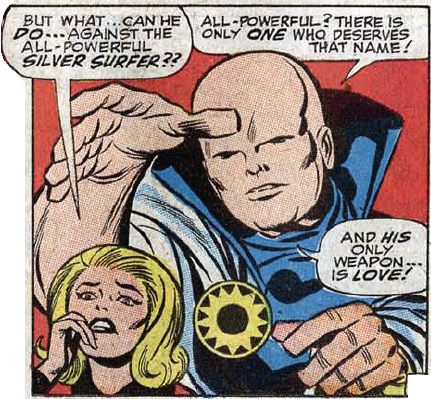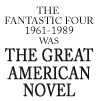







 |
 |
 |
 |
 |
 |
 |
 |
realistic space travel
---- the source of their
powers ---- cosmically
powerful beings ---- alien technology

In FF13, over a year after the test flight in FF1, the team still lacked a power source to get as far as the moon. Then Reed made a lucky discovery: an exotic meteor that packed a huge amount of chemical energy. He hoped to learn from it, to make better rocket fuels, but it was never mentioned again. It seems that the meteor was used up in a single flight.

The FF did not then have the power to reach the moon in issue 1. So when in FF2 Reed disparagingly calls it "our flight to Mars" he is using hyperbole. Mars was never suggested as a destination at any other time.
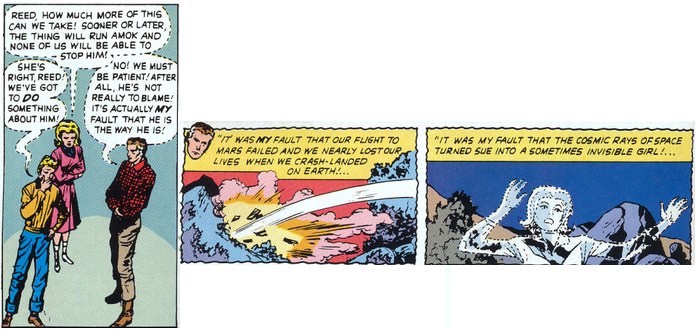
Look at the context: he's exaggerating his failure, just as he exaggerates his culpability. In reality it was not a flight to Mars, and in reality he was not the sole cause of Ben's disfigurement. Nobody could have known what would happen, and anyway it was Sue, not Reed, who persuaded Ben to come. Reed is clearly exaggerating.
What about their flying saucer"In issue 7 the team gained access to an alien saucer that was later used for rescuing Ben Grimm. Other than that, all their technology was strictly earth level, but augmented by whatever Reed could salvage from alien tech.
This is why the American moon landing in 1969 was still a giant leap for mankind: it was the first time mankind did it. When Reed did it he was simply using alien tech that he got by luck. He had no real control over it: and it looks like the flying saucer, like the meteor rocket fuel, was only good for one more flight. It may be that only super powered beings could survive using this equipment: it was not designed for humans.
So saying that Reed got to the moon first is like saying that a guy picked up in a whirlwind was the first man to fly. It wasn't man doing it, so it doesn't count.
What about FF 37, "behold a distant star?"The "space craft" in FF37 barely travels in space at all, but travels in sub space. It has to begin its journey just outside Earth's atmosphere, but ends the journey (and starts the return trip) inside the Skrull atmosphere (see the photo montage in issue 37). Reed explains that the craft does not travel far in space: most of the journey takes place in a space-time warp. The craft has enough fuel to rise from the ground on the Skrull world, but needs a conventional Saturn booster rocket to leave Earth's atmosphere.
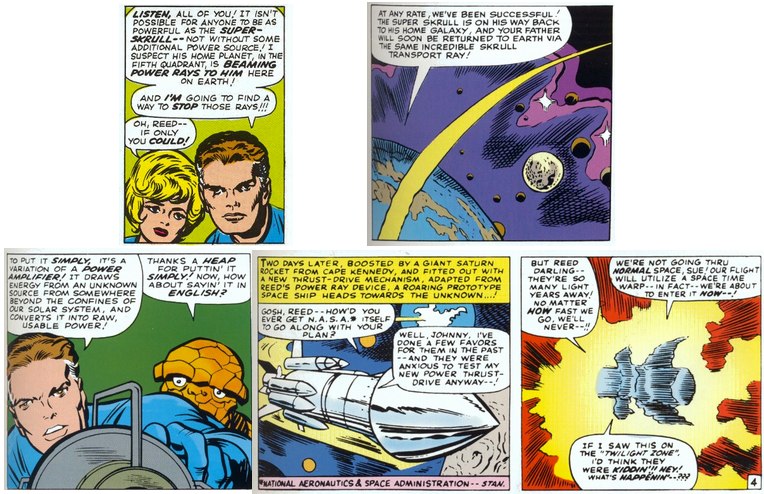
Note: the image of leaving Earth in issue 37 may look like the team have reached the moon, but this is standard Jack Kirby stylized art, where all planets are shown as being very close - note all the other planets hovering near Earth in both pictures.
This craft utilizes the Skrull transport ray seen in FF18 and
FF32. How do we know? First, the ship is based on Reed's power ray
device. Reed states that the power ray device gains its energy
from "an unknown source from somewhere beyond the confines of our
solar system." Clearly he does not know much about how it works,
so he cannot have invented it. This power ray also doubles as a
transport ray, just like the one that delivered and powers the
Super-Skrull (FF18 and 32) and later brought Sue's father (FF32).
The whole purpose of this journey is to find the people on the
other end of that transport ray. How else could they be found,
given the vast size of the universe, except by following the path
of the original transport ray? It appears certain that Reed's
"space craft" is a short range rocket that's designed for only one
purpose: to use the Skrull transport ray.
The mystery of what caused the Fantastic Four's mutations is a sub plot that runs the whole length of the original story, from 1961 to 1988. We are given a number of clues. in FF29 the Molecule Man receives even more amazing powers in a similar way (a freak accident). In the rest of the Marvel Universe this kind of thing happens many times. In the rest of the Marvel Universe we gradually learn how superpowers appear. This is summarized in the Fantastic Four magazine at the end of Act 5 (FF319), like a TV detective explaining how the pieces fit together. FF319 does not explicitly state that this this explains the Fantastic Four, but the same character (Kubik) gives that as his opinion in FF351:
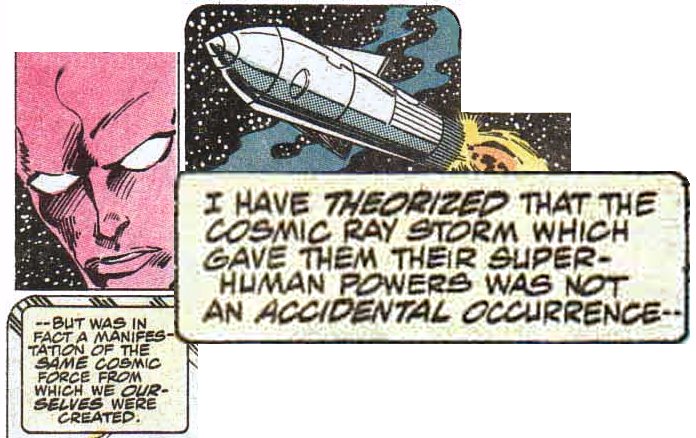
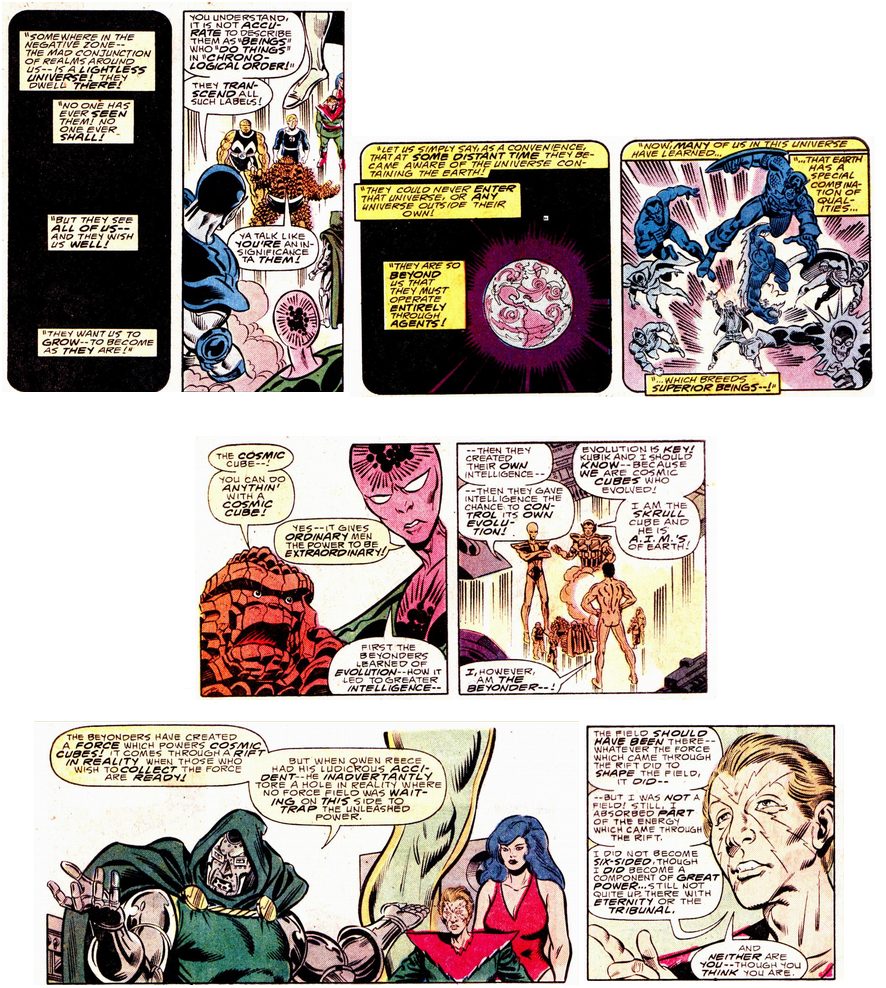
A summary:
The idea that these superpowers are a message from a higher power is expanded in FF529, where an alternate Reed says:
"For years, space agencies around the world have been sending probes and signals into space, looking for an answer from another civilization. The process requires someone to receive the signal, decode it, and respond appropriately. Otherwise there can't be any communication. The way the cosmic rays affected all of us in ways that reflect our personalities implies direction, and direction implies intelligence. All of which leads me to believe that the cosmic rays may have been an attempt to communicate with us, a signal which until now has gone unrecognized."
The ultimate purpose of that communication seems to be to create Franklin. The Celestials explain, in the first 2 issues of the Heroes Reborn: The Return:
"We
conduct experiments, too. And one of them was on this world
as life developed. But we have accomplished all we have set out
to do. To make you, Franklin. Or someone like you."
The Cosmic Cube theory of superpowers is a variation of a well known idea. It's also seen in Carl Sagan's "First Contact," Arthur C Clarke's "Childhood's End" and "2001: a Space Odyssey" and in many other places:
Aliens exist, and once we become sufficiently advanced to contact them they will offer us great power.
This concept is also the basis of religion and magic. Don't
scoff, it is based on a simple idea that is the basis for schools,
and all forms of organization: other people know more than we do,
and they will help us if we pass their tests.
Carl Sagan is not a person given to wild magical stories. It seemed likely to him, and to perhaps most cosmologists, that alien life must exist. Life evolved on Earth almost as soon as it was possible to evolve, which indicates it cannot have been that difficult: if you roll a hundred dice and get a hundred sixes with your first attempt, this strongly suggests that the dice are loaded in your favor.
Is alien life advanced? If alien life is relatively common, then the size the universe indicates that a large number of alien species must be advanced: there are billions of galaxies, each with billions of stars.
How advanced is it? If any aliens reach our level of technology and continue just a few thousand years they will be vastly, vastly superior. A few thousand years is nothing on a cosmic scale. And this assumes they all use our methods: perhaps the aliens are giant gas clouds or subatomic, and perform quantum calculations automatically.
Could they contact us?The big problem seems to be the speed of light, but intelligence always finds a way round obstacles eventually. Perhaps one of the faster than light theories is correct. Or perhaps multiple dimensions overlap. Or perhaps life can evolve in one of the sub-atomic dimensions (String theory posits many tiny dimensions). So advanced aliens are probably common.
Then where are they? The "SETI paradox" is, "if the universe is full of aliens then where are they?" But advanced aliens are probably fabulously more advanced than us, so we would not recognize them.
Would they be interested in us? Yes. Development is based on information and resources: we advance by becoming able to handle information more efficiently so that we can use resources more efficiently. Planets are a resource. And advanced race would know about them all, and would be interested in them all.
Would they be benevolent? Yes. Even if just by controlling our minds without us realizing. Fighting is a waste of resources. If advanced aliens wanted what we have then they would change our minds without us realizing. So they want is what we want.
Incidentally, another variation on this argument is the matrix hypothesis. For a fuller description click here, but in brief the argument goes like this:
You may of course disagree with any of these points, but the
point is that these are all arguments
based on probabilities: it is an argument that each
conclusion is the most realistic
possibility.
Conclusion
Arthur C Clarke's 2001 is not such a crazy idea. We could make contact with aliens (who would boost our evolution) at any point. We probably won't any time soon, but it's like throwing all sixes with dice: it can happen at any time.
Yet the fact remains that these particular sixes have not yet been rolled. We don't see Fantastic Four style superpowers in the real world... yet. But given the advances in exoskeletons and nanotechnology they are only a few decades or centuries away. At the end of the
Marvel universe, in 1990, the FF annual explained
everything.
The main story explained the Franklinverse, and the backup story explained cosmic beings.
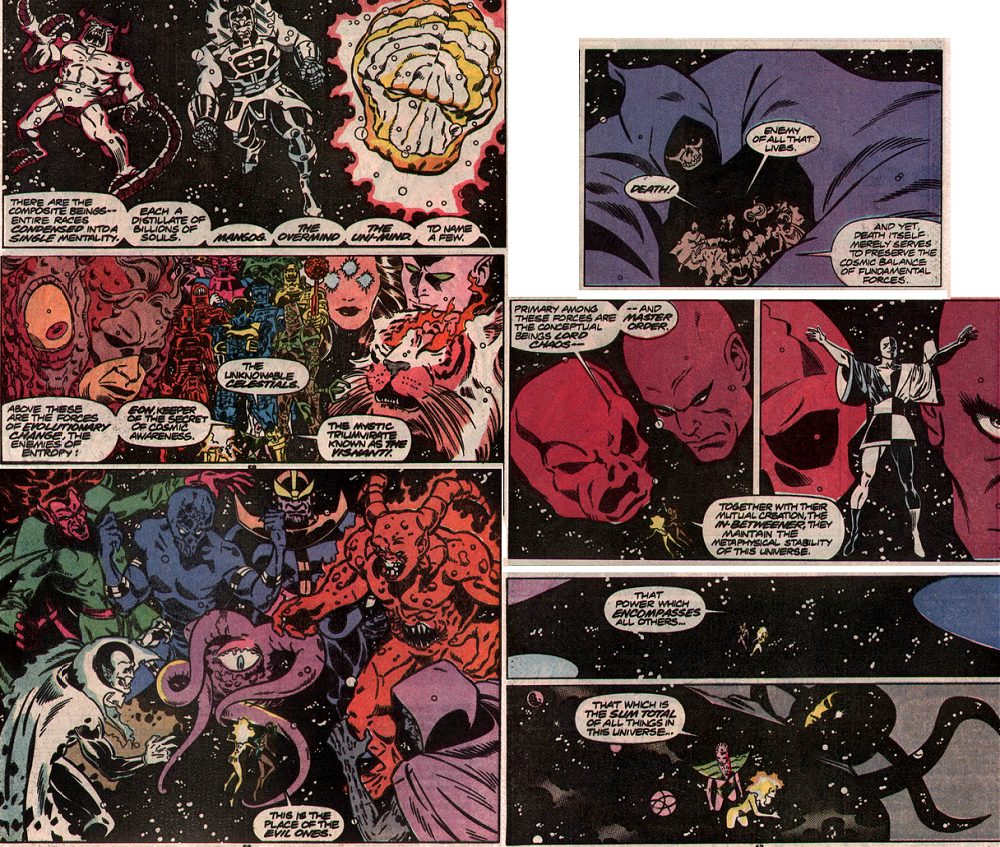
To understand higher beings we need to understand higher
dimensions. The simplest way is to imagine what our three
dimensional world looks like to lower dimensions. This is explored
in the famous book "flatland." Imagine a world that only existed
on a flat surface: as a three dimensional being you could see
everything inside it and they could not see you. Unless you
touched it. If you touched it with five fingers they would see
five circles, and not know those circles were connected.
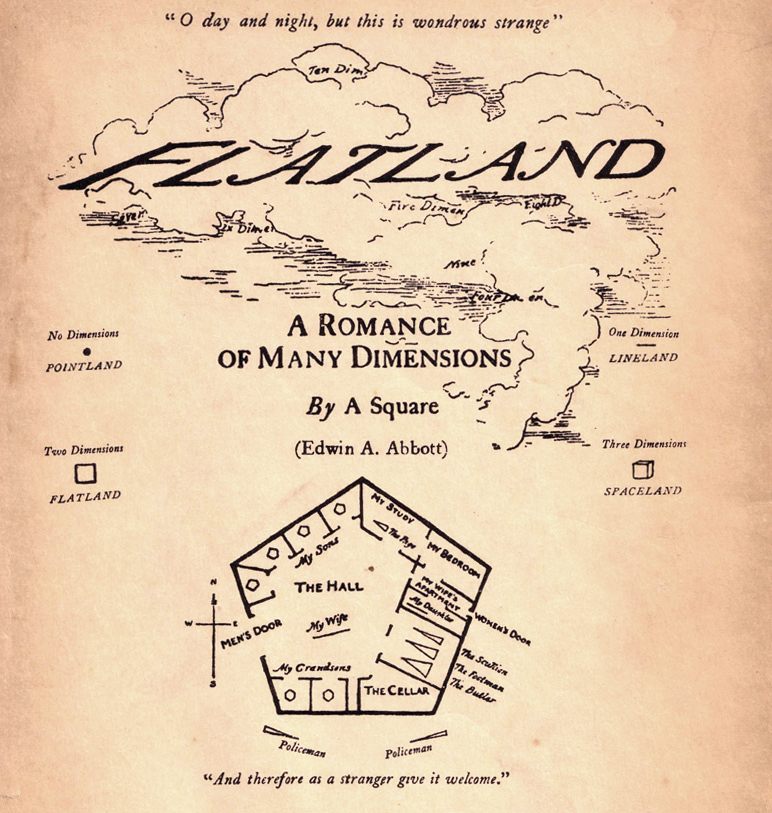
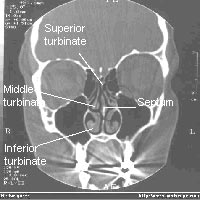
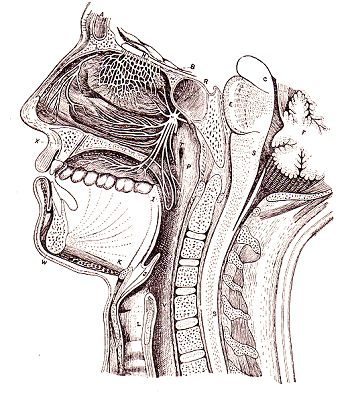
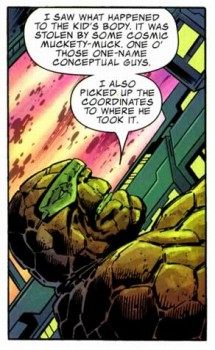
because these beings are abstract concepts they can never actually
be destroyed, they simply reflect how we see things. For example,
if we are evil then the concept that embodies evil will return.
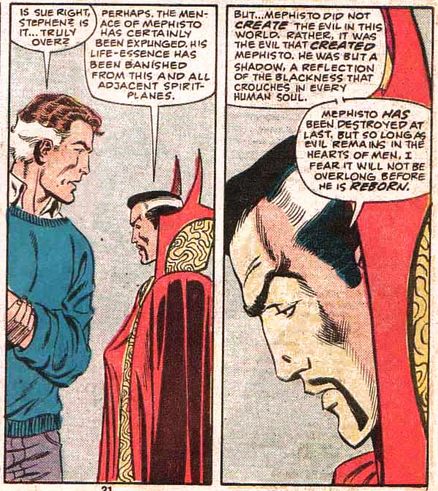
Now let us consider the best known higher being in comics:
Galactus.
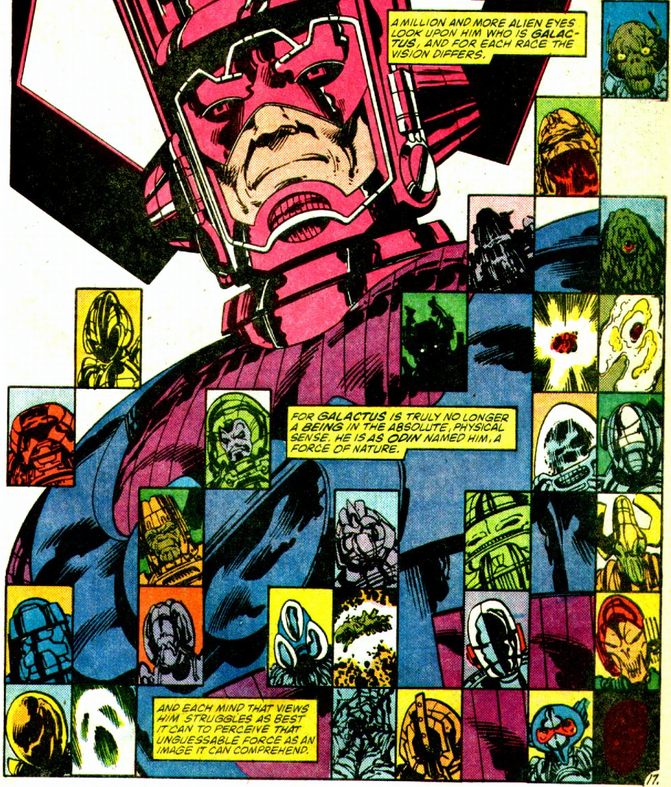
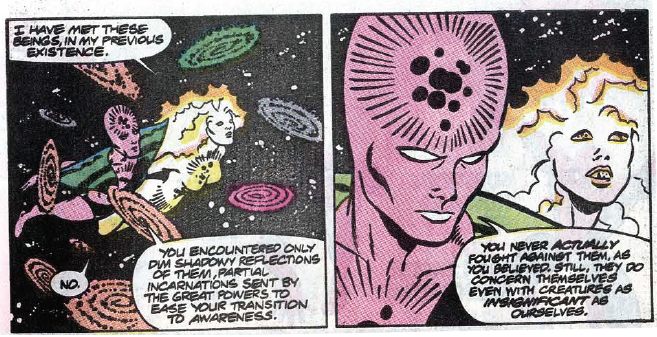

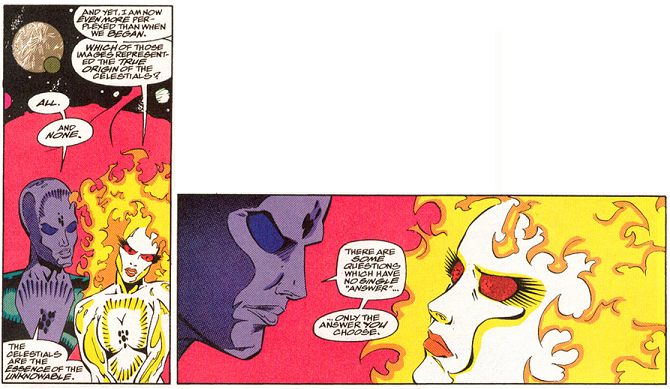
The conclusion to annual 23 is that scale is an illusion.
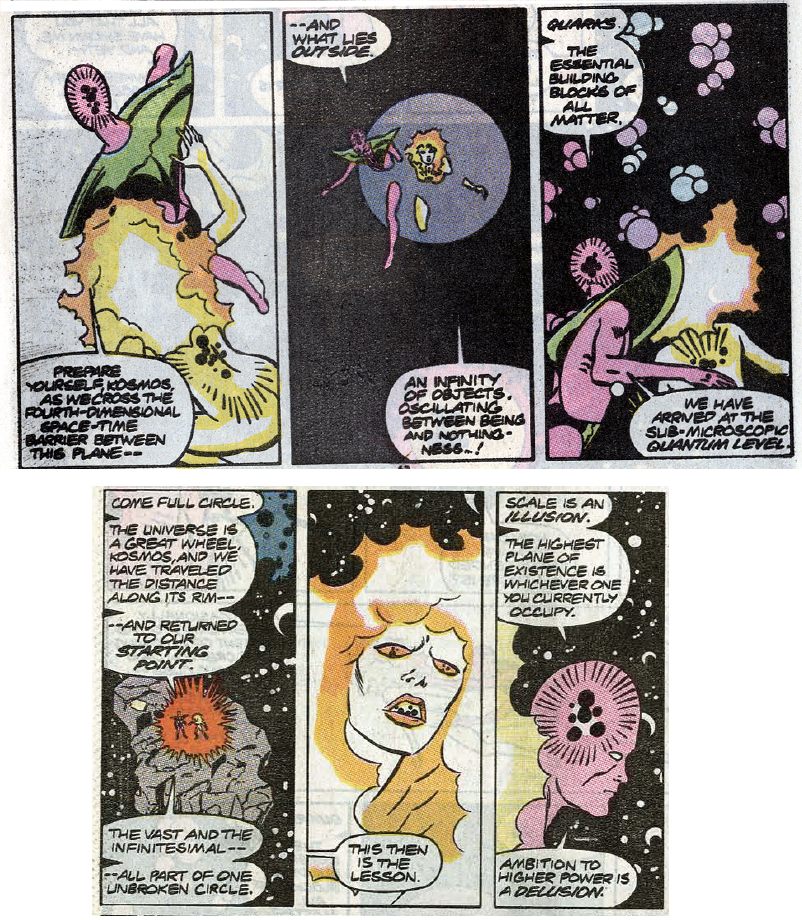
FF319 is the other key text for understanding higher beings. We
see two fragments of one cosmic cube: together it is a cube. But
separately it is two beings: the molecule man and the Beyonder.
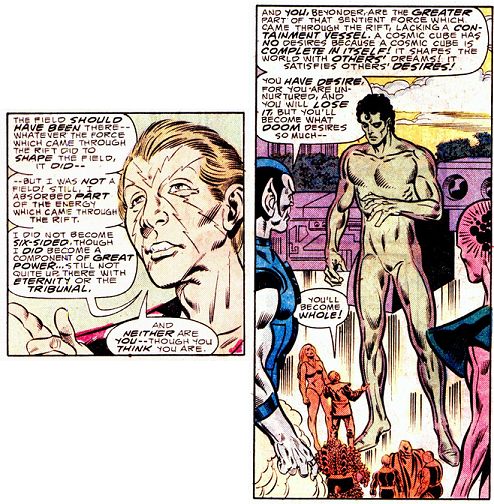
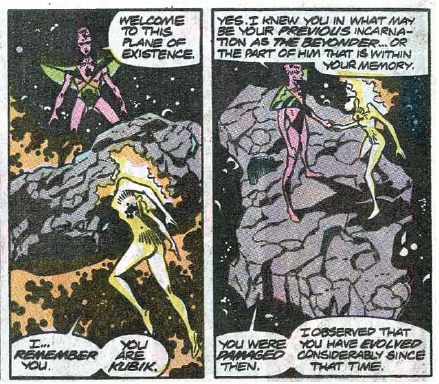
Now we are ready to go back to basics. The expert on all things
is the Watcher. When Galactus first appeared he revealed the
simple truth: there are only two known beings at his power level:
Galactus and the Watchers. Just two.
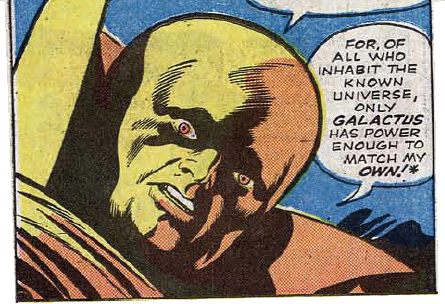
Later the Watcher refers to an even higher being or principle:
one that works on love.
